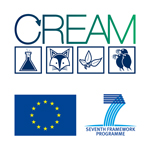CREAM
 |
Mechanistic Effect Models for Ecological Risk Assessment of Chemicals |
|
Research
Context and Issues
According to EU regulations (e.g. EC 1107/2009), environmental risk assessment of chemicals aims to achieve sustainable populations of non-target species in the wild. Population-level effects depend not only on exposure and toxicity, but also on important ecological factors that are impossible to fully address empirically. Mechanistic effect models (MEMs) enable integration of these factors, thus increasing the ecological relevance of risk assessments as well as providing vital understanding of how chemicals interact with ecosystems. However, ecological models that can predict the effect of chemicals are lacking for risk assessment for a number of relevant species. Moreover, lack of understanding of these models by regulators and inconsistent approaches applied by researchers and users have led to scepticism. Increasing transparency and rigorous model development and evaluation are core elements of the modelling process which have to be emphasised to support a wider use of MEMs in risk assessment.
Objectives
In this context, the aim of the CREAM project is three-fold:
- train scientists, post-doctoral researchers and Ph.D. students in both MEMs and regulatory risk assessment
- formulate Good Modelling Practice to be followed in all individual projects, thus leading to consistency and transparency
- develop and experimentally validate a suite of MEMs for species relevant for chemical risk assessments. In this respect, specific objectives at INRA focus on the development of mechanistic models that predict effects of chemicals on the freshwater gastropod Lymnaea stagnalis, a species that the OECD proposes as a standard test species in aquatic ecotoxicology.
Methodology
Effect models for L. stagnalis aim to predict adverse effects of chemicals on survival, development, growth and reproduction over the life-cycle of the snail. These models have been developed in two complementary Ph.D. projects: DEB-1 and DEB-2 (further details here. Both projects require combining laboratory toxicity tests and mechanistic modelling. The Dynamic Energy Budget (DEB) theory is used as a basis for model development. In the DEB-1 project, DEB theory is used to understand how environmental stressors (e.g. food limitation, mating regime) affect the physiology of L. stagnalis, and consequently determine life-cycle traits values of individuals. In the DEB-2 project, DEB theory is used to investigate how physiological changes induced by chemicals could alter growth, maturity and reproduction. Different scenarios for putative mechanisms of action that explain the observed effects on individual life-cycle traits are studied. Focus is on endocrine-active substances, for which complex dose-responses can occur.
Results
- A DEB model was developed for L. stagnalis, allowing prediction of individual survival, growth development and fecundity over the whole life-cycle, while distinguishing male and female functions, which influences reproductive responses to endocrine disruptors (DEB-1 project). This model has a rather high level of complexity, which is adequate for scientific research but impractical for application to risk assessment.
- A simpler version of the model (called DEBkiss) is currently being tested and evaluated in the DEB-2 project to assess its ability to predict adverse effects of chemicals, particularly endocrine-active substances, on the pond snail. Initial results with acetone and tributyltin are encouraging. The DEBkiss model will have to be compared to other toxicokinetics-toxicokdynamics models currently being developed to analyse sublethal effects of chemicals (e.g. Sibly et al. 2013).
- Both projects helped identify confounding experiment-related factors in toxicity tests with L. stagnalis (i.e. food quality and availability, carrier solvent concentration, snail density)
- Matlab scripts for all of these models are available online
Publications issued from the project
People involved
 |
BARSI Alpar, Ph.D. Student Phone : +31 6 49 86 13 84 Email : alpar.barsi@inrae.fr |
 |
COLLINET Marc, Technician Phone : +33 2 23 48 55 29 Email : marc.collinet@inrae.fr |
 |
DUCROT Virginie, Scientist Phone : +33 2 23 48 56 25 Email : virginie.ducrot@inrae.fr |
 |
LAGADIC Laurent, Scientist Phone : +33 2 23 48 52 37 Email : laurent.lagadic@inrae.fr |
Partners
Funding and Support
The European Commission 7th Framework Programme
